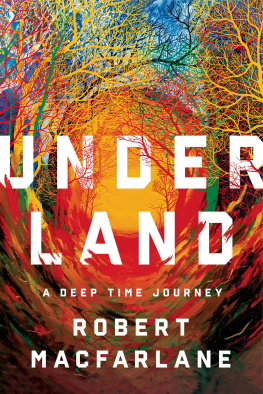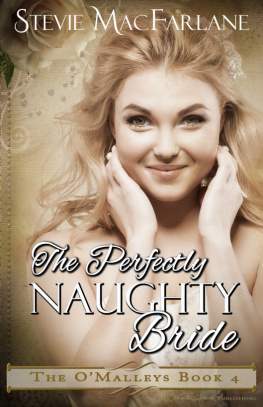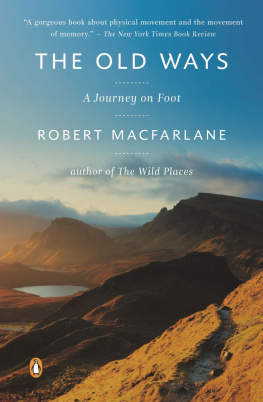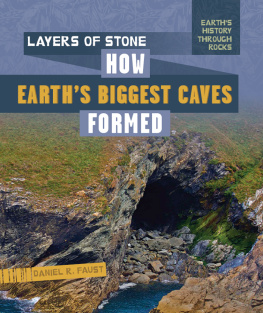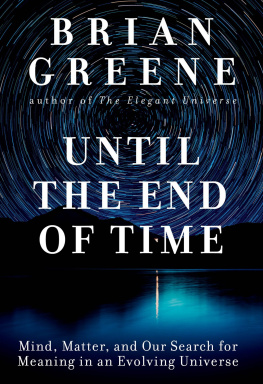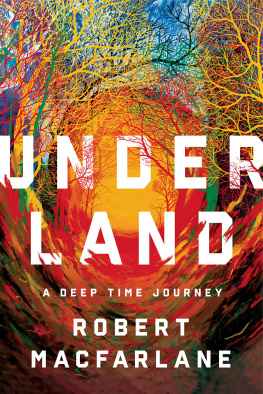
UNDERLAND
A Deep Time Journey
ROBERT MACFARLANE

W. W. NORTON & COMPANY
Independent Publishers Since 1923
New York | London
Is it dark down there
Where the grass grows through the hair?
Is it dark in the under-land of Null?
Helen Adam, Down There in the Dark, 1952
The void migrates to the surface...
Advances in Geophysics, 2016
Contents

The way into the underland is through the riven trunk of an old ash tree.
Late-summer heatwave, heavy air. Bees browsing drowsy over meadow grass. Gold of standing corn, green of fresh hay-rows, black of rooks on stubble fields. Somewhere down on lower ground an unseen fire is burning, its smoke a column. A child drops stones one by one into a metal bucket, ting, ting, ting.
Follow a path through fields, past a hill to the east that is marked by a line of nine round burial barrows, nubbing the land like the bones of a spine. Three horses in a glinting cloud of flies, stock-still but for the swish of a tail, the twitch of a head.
Over a stile in a limestone wall and along a stream to a thicketed dip from which grows the ancient ash. Its crown flourishes skywards into weather. Its long boughs lean low around. Its roots reach far underground.
Swallows curve and dart, feathers flashing. Martins criss-cross the middle air. A swan flies high and south on creaking wings. This upper world is very beautiful.
Near the ashs base its trunk splits into a rough rift, just wide enough that a person might slip into the trees hollow heart and there drop into the dark space that opens below. The rifts edges are smoothed to a shine by those who have gone this way before, passing through the old ash to enter the underland.
Beneath the ash tree, a labyrinth unfurls.
Down between roots to a passage of stone that deepens steeply into the earth. Colour depletes to greys, browns, black. Cold air pushes past. Above is solid rock, utter matter. The surface is scarcely thinkable.
The passage is taken; the maze builds. Side-rifts curl off. Direction is difficult to keep. Space is behaving strangely and so too is time. Time moves differently here in the underland. It thickens, pools, flows, rushes, slows.
The passage turns, turns again, narrows and leads into surprising space. A chamber is entered. Sound now booms, resonates. The walls of the chamber appear bare at first, but then something extraordinary happens. Scenes from the underland start to show themselves on the stone, distant from one another in history, but joined by echoes.
In a cave within a scarp of karst, a figure inhales a mouthful of red ochre dust, places its left hand against the cave wall fingers spread, thumb out, palm cold on the rock and then blows the ochre hard against the hands back. There is an explosion of dust and when the hand is lifted its ghostly print remains, the stone around having taken the red of the ochre. The hand is shifted, more dust is blown and another pale outline is left. Calcite will run over these prints, sealing them in. The prints will survive for more than 35,000 years. Signs of what? Of joy? Of warning? Of art? Of life in the darkness?
In the shallow sandy soil of northern Europe, some 6,000 years ago, the body of a young woman dead in childbirth along with her son is lowered gently into a grave. Next to her is laid the white wing of a swan. Then onto the wing is placed the body of her son, so that the baby is doubly cradled in death by the swans feathers and his mothers arms. A round mound of earth is raised to mark their burial place: the woman, the child and the white swans wing.
On an island in the Mediterranean 300 years before the founding of the Roman Empire, a metalworker completes the design of a silver coin. The coins face shows a square labyrinth with a single entrance on its upper edge and a complex path to its centre. The walls of the labyrinth like the rim of the coin are slightly raised and polished to a sheen. Tooled into the labyrinths centre is the figure of a creature with the head of a bull and the legs of a man: the Minotaur, waiting in darkness for whatever comes next.
Six hundred years later, a young woman sits for a portrait painter in Egypt. She has dressed most handsomely for the sitting. She has strong dark eyebrows and wide dark eyes, almost black. Her hair is pulled back from her forehead by a metal band topped with a gold bead, and she wears a golden scarf and brooch. The painter works with hot beeswax, gold leaf and coloured pigments, layering them onto wood. He is creating the young womans death image. When she dies it will be wrapped into the bands of cloth used to mummify her corpse such that it takes the place of her real face. As her body decays beneath its swaddling, the portrait will remain un-aged. It is well to do such things early, when one looks most glowing. Her body will be placed in a necropolis a city of the dead built at the entrance to a sunken depression of desert, in a buried chamber lined with limestone and covered with quartzite slabs to deter grave robbers, close to vaults that hold the mummified corpses of more than a million ibises.
Beneath a plateau in southern Africa, late in the nineteenth century, miners crawl through miles of narrow tunnel cut deeper underground here than anywhere else on Earth at this time lugging ore from a sunken reef of gold. Some of these men, who have migrated to the area in their thousands to work, will die soon in rockfalls and accidents. More will die slowly of silicosis from breathing the rock dust down there in the killing dark, year after year. Here the human body is largely disposable in the view of the corporations that own the mine and the markets that drive it: a small, unskilled tool of extraction to be replaced when it fails or wears out. The ore the men bring up is crushed and smelted, and the wealth it yields lines the pockets of shareholders in distant countries.
In a cave in the foothills of the Indian Himalayas not long after Partition, a young woman meditates sixteen hours a day, for seventy- five days. She sits stone-still while meditating, save for her mouth, which moves as she murmurs mantras. She emerges most often at night; when it is cloudless the Milky Way can be seen spilling across the sky above the peaks. She lives on water drunk with cupped hands from a sacred river, and on foraged wild berries and fruits. The mantras, the solitude and the darkness bring perceptions that are new to her, and she experiences a profound change in her vision. When at last she completes her retreat she feels vast as the skies, old as the mountains, formless as starlight.
Thirty years ago a boy and his father use the claw of a hammer to prise up a floorboard in a house they are soon to leave. They have made a jam-jar time capsule. Into the jar the boy has placed objects and messages. The die-cast metal model of a bomber aeroplane. The outline of his left hand traced in red ink on plain paper. A self-description for whoever finds the jar Quite tall for my age, very blonde hair, almost white. Biggest fear, nuclear war written in pencil on a notebook page. A stopped watch with luminous hands and dial, around which he likes to cup his hands to see the numbers glow. He pours a handful of rice into the jar to absorb moisture, screws the jars brass lid tightly shut, puts it in its hiding place and nails the floorboard back down.
Deep in an extinct volcano a tunnel network has been bored above a crustal fault known as Ghost Dance. Access drifts incline through tilted strata to level out in a repository zone, organized into emplacement corridors. The intent is to inter high-level nuclear waste in these corridors: radioactive uranium pellets encased in iron, then encased in copper, then buried above the Ghost Dance fault to pulse out their half-lives for millions of years to come. The timescale of the hazard is such that those responsible for entombing this waste must now face the question of how to communicate its danger to the distant future. This is a risk that will outlast not only the life of its makers but perhaps also the species of its makers. How to mark this site? How to tell whatever beings will come to this desert place that what is kept in this rock sarcophagus is desperately harmful, is
Next page
